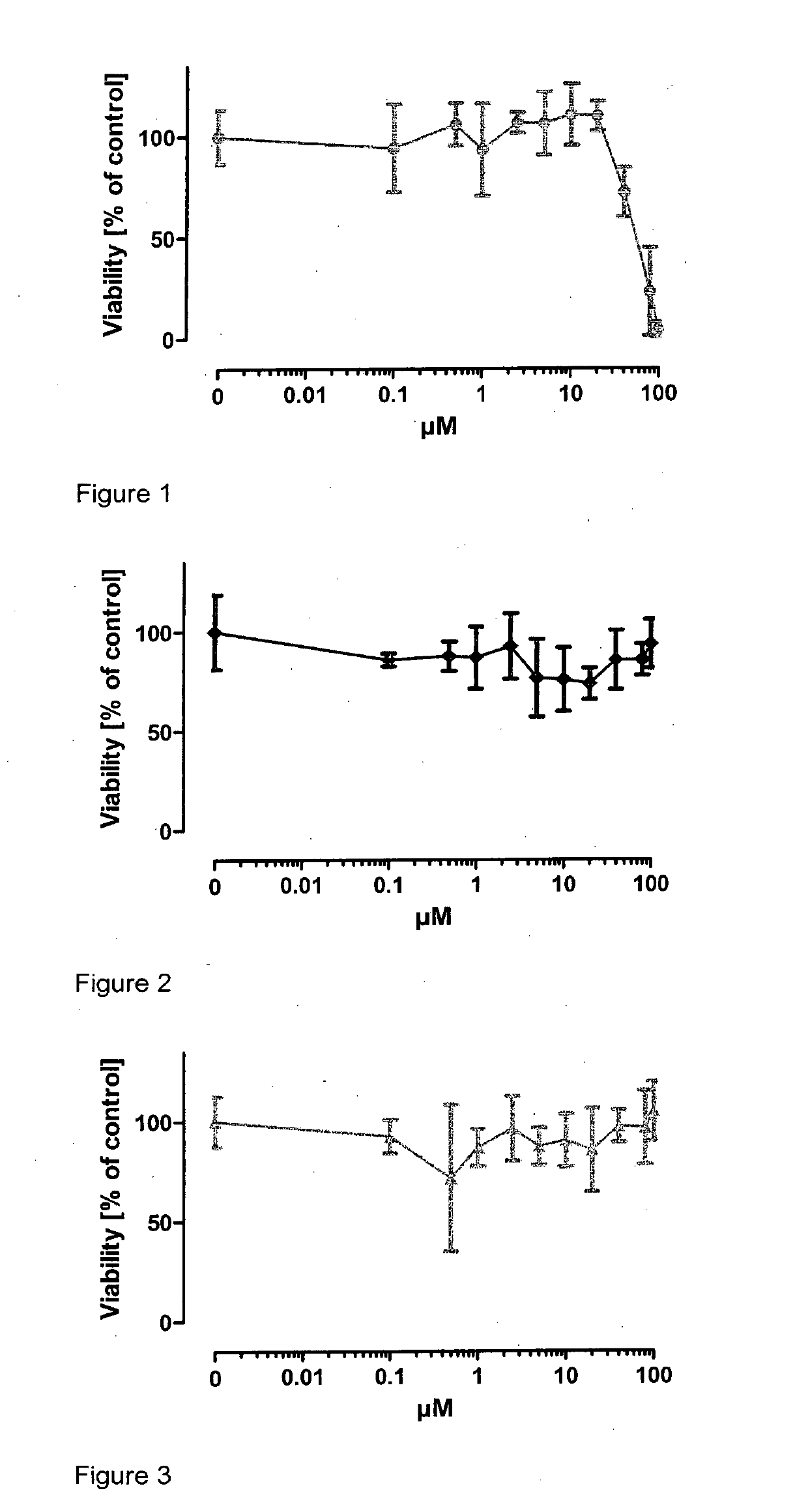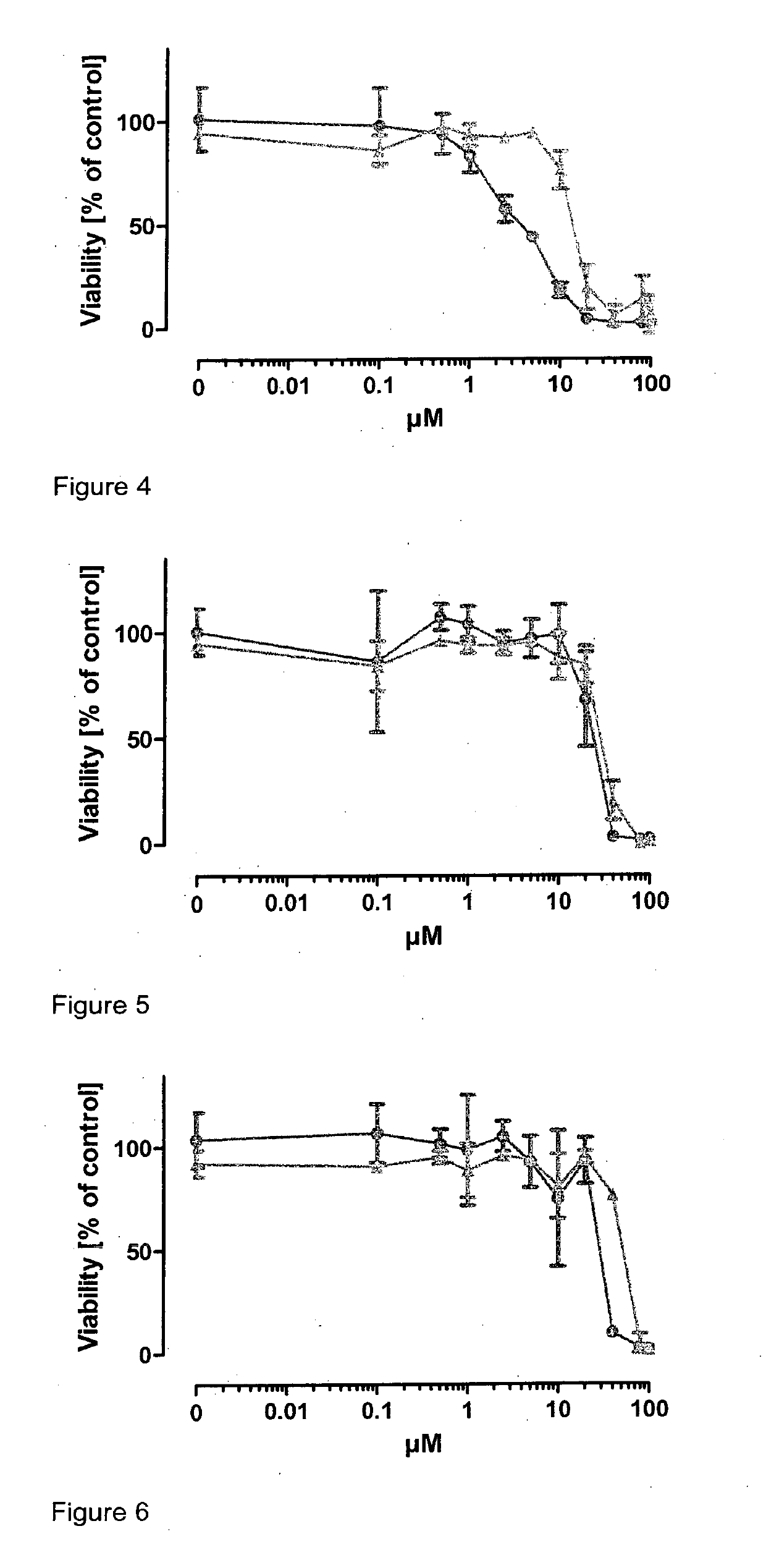Compounds for use as an Anti-bacterial or Anti-fungal agent and as a zinc sensor
a technology of antibacterial or antifungal agents and compounds, which is applied in the direction of plant growth regulators, biocide, animal husbandry, etc., can solve the problems that many antibiotics cannot be used for treating bacterial and/or fungal infections, aeruginosa poses major threats to public health, and the emergence of antibiotic resistance currently poses a major threat to public health
- Summary
- Abstract
- Description
- Claims
- Application Information
AI Technical Summary
Benefits of technology
Problems solved by technology
Method used
Image
Examples
example 2
of 1-Te-HHQ (Compound 2)
[0091]
Synthesis of 1-(2-bromophenyl) dec-2-yn-1-one (2a)
[0092]
[0093]Under argon, 2.096 g (9.55 mmol) o-bromobenzoyl chloride was solved in 30 ml dry THF and 110 mg (0.157 mmol) PdCl2[Ph3P]2 and 1.4 ml (10.06 mmol) TEA were added and stirred for 10 min at room temperature. 69 mg (0.36 mmol) CuI was added and stirred for 10 min at room temperature and 819 mg (6.6 mmol) 1-nonyne was added. After 18 h at room temperature the solvent was evaporated and the residue diluted with ethyl acetate and washed twice with water and one time with brine. The solvent was evaporated and the residue purified by column chromatography on silica gel using n-hexane / ethyl acetate (95:5). The product was obtained as yellow oil (1.756 g, 87%). Rf=0.33 (n-hexane / ethyl acetate 95:5). 1H-NMR (CDCl3 399.79 MHz) δ (ppm): 0.89 (m, 3H, —CH3), 1.26-1.37 (m, 6H, —CH2—(CH2)3—CH3), 1.44 (m, 2H, —CH2—(CH2)3—CH3), 1.64 (m, 2H, —CH2—(CH2)4—CH3), 2.46 (dd, J=7.5 Hz, J=7.2 Hz, 2H, —CH2—(CH2)5—CH3), 7....
example 3
of HHQ-Oxime (Compound 3)
[0096]
Synthesis of 4-(benzyloxy)-2-heptyl-1,4-dihydroquinoline (3a)
[0097]
[0098]0.297 g (1.22 mmol) 2-heptylquinolin-4(1H)-one and 78 mg NaH (1.95 mmol, 60% in mineral oil) were dissolved in 6 ml dry DMF under nitrogen atmosphere and were stirred for 30 min at room temperature. 227 mg (1.8 mmol) benzyl chloride was solved in 4 ml DMF and added to the reaction dropwise. The reaction was stirred at room temperature for 2 h and quenched by the addition of 5 ml water. Water and DMF were evaporated under reduced pressure at 60° C. The residue was solved in DCM and washed twice with water and once with brine, dried with MgSO4, filtered and evaporated. The residue was purified by column chromatography on silica gel using DCM / MeOH (30:1). The product was received as a colorless oil (143 mg, 35%). Rf=0.95 (DCM / MeOH (30:1). 1H-NMR (CDCl3 399.79 MHz) δ (ppm): 0.89 (m, 3H, H-15), 1.20-1.40 (m, 8H, H-11-14), 1.76 (m, 2H, H-10), 2.88 (m, 2H, H-9), 5.37 (s, 2H, —O—CH2—Ar), ...
example 5
of 2-heptyl-3-hydroxy-4H-thiochromen-4-one, 1-S-PQS
[0110]
[0111](Compound 5)
Synthesis of 2-heptylthiochroman-4-one (5a)
[0112]
[0113]Under nitrogen atmosphere octanal (0.842 g, 6.57 mmol) was dissolved in 33.33 mL dry toluene and pyrrolidine (0.234 g, 3.285 mmol) was added. The solution becomes murky and after 10 minutes 1.00 g (6.57 mmol) of 2-thioacetophenone were added carefully. After it was stirred for 30 minutes at room temperature the solution became clear and yellow and the temperature was raised to 110° C. The reaction was refluxed for 3 h and when it was cooled to room temperature the mixture was diluted with diethyl ether, washed with saturated NaHCO3 solution, water and brine. The organic solution was dried over MgSO4, evaporated and the pure product was obtained over silica gel chromatography in n-hexane / ethyl acetate 9:1 as a yellow oil (0.702 g, 41%). Rf=0.51 (n-hexane / ethyl acetate 12:1). 1H-NMR (CDCl3 400.13 MHz) δ (ppm): 0.88 (t, J=7.1 Hz, 3H, H-15), 1.20-1.35 (m, 8H,...
PUM
 Login to View More
Login to View More Abstract
Description
Claims
Application Information
 Login to View More
Login to View More - R&D
- Intellectual Property
- Life Sciences
- Materials
- Tech Scout
- Unparalleled Data Quality
- Higher Quality Content
- 60% Fewer Hallucinations
Browse by: Latest US Patents, China's latest patents, Technical Efficacy Thesaurus, Application Domain, Technology Topic, Popular Technical Reports.
© 2025 PatSnap. All rights reserved.Legal|Privacy policy|Modern Slavery Act Transparency Statement|Sitemap|About US| Contact US: help@patsnap.com



